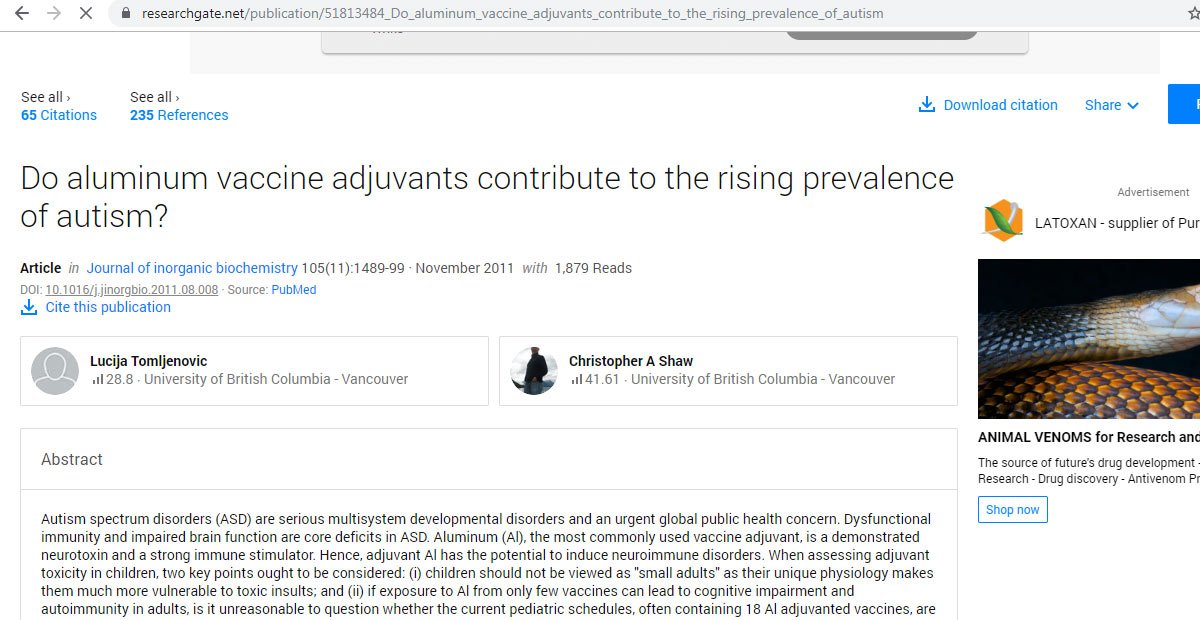¿Los adyuvantes de la vacuna de aluminio contribuyen a la creciente prevalencia del autismo?
J Inorg Biochem. 2011 Nov;105(11):1489-99. Epub 2011 Aug 23. Tomljenovic L, Shaw CA.
Article inJournal of inorganic biochemistry 105(11):1489-99 · November 2011 with 1,916 Reads DOI: 10.1016/j.jinorgbio.2011.08.008 · Source: PubMed
Neural Dynamics Research Group, Department of Ophthalmology and Visual Sciences, University of British Columbia, 828 W. 10th Ave, Vancouver, BC, Canada V5Z 1L8
Resumen
La inmunidad disfuncional y la función cerebral alterada son déficits centrales en los TEA. El aluminio (Al), el adyuvante de vacuna más utilizado, es una neurotoxina demostrada y un fuerte estimulador inmunitario. Por lo tanto, el adyuvante de Aluminio, Al tiene el potencial de inducir trastornos neuroinmunes.
Necesitamos traductores, contactenos
Abstract Autism spectrum disorders (ASD) are serious multisystem developmental disorders and an urgent global public health concern. Dysfunctional immunity and impaired brain function are core deficits in ASD. Aluminum (Al), the most commonly used vaccine adjuvant, is a demonstrated neurotoxin and a strong immune stimulator. Hence, adjuvant Al has the potential to induce neuroimmune disorders. When assessing adjuvant toxicity in children, two key points ought to be considered: (i) children should not be viewed as «small adults» as their unique physiology makes them much more vulnerable to toxic insults; and (ii) if exposure to Al from only few vaccines can lead to cognitive impairment and autoimmunity in adults, is it unreasonable to question whether the current pediatric schedules, often containing 18 Al adjuvanted vaccines, are safe for children? By applying Hill’s criteria for establishing causality between exposure and outcome we investigated whether exposure to Al from vaccines could be contributing to the rise in ASD prevalence in the Western world. Our results show that: (i) children from countries with the highest ASD prevalence appear to have the highest exposure to Al from vaccines; (ii) the increase in exposure to Al adjuvants significantly correlates with the increase in ASD prevalence in the United States observed over the last two decades (Pearson r=0.92, p<0.0001); and (iii) a significant correlation exists between the amounts of Al administered to preschool children and the current prevalence of ASD in seven Western countries, particularly at 3-4months of age (Pearson r=0.89-0.94, p=0.0018-0.0248). The application of the Hill’s criteria to these data indicates that the correlation between Al in vaccines and ASD may be causal. Because children represent a fraction of the population most at risk for complications following exposure to Al, a more rigorous evaluation of Al adjuvant safety seems warranted. 22 23 24 Administration of aluminium to neonat

 CienciaySaludNatural.com
CienciaySaludNatural.com




